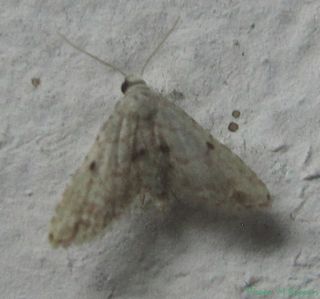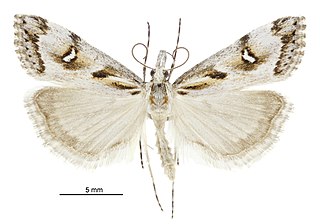Hyodectis is a genus of moth in the family Gelechiidae. It contains only one species, Hyodectis crenoides, which is found in Australia, where it has been recorded from New South Wales and Victoria.

Metasia is a genus of moths of the family Crambidae.

Udea is a genus of snout moths in the subfamily Spilomelinae of the family Crambidae. The genus was erected by Achille Guenée in 1845. The currently known 214 species are present on all continents except Antarctica. About 41 species are native to Hawaii.

Scoparia is a grass moth genus of subfamily Scopariinae. Some authors have assigned the synonymous taxon Sineudonia to the snout moth family (Pyralidae), where all grass moths were once also included, but this seems to be in error.

Araeopteron is a genus of moths of the family Erebidae. The genus was erected by George Hampson in 1893.

Corgatha is a genus of moths of the family Erebidae erected by Francis Walker in 1859.
Xyrosaris is a genus of moths of the family Yponomeutidae.

Pyrgotis is a genus of moths belonging to the subfamily Tortricinae of the family Tortricidae. This genus was first described by Edward Meyrick in 1881.
Dryadaula are a genus of moths belonging to the family Tineidae. It was described by Edward Meyrick in 1893, and is the sole genus of the family.
Emmalocera is a genus of snout moths. It was described by Émile Louis Ragonot in 1888.
Ascalenia exodroma is a moth in the family Cosmopterigidae. It was described by Edward Meyrick in 1897. It is found in Australia, where it has been recorded from Queensland.
Ascalenia semnostola is a moth in the family Cosmopterigidae. It was described by Edward Meyrick in 1897. It was described from the Australian state of New South Wales, but has also been recorded from South Africa.

Gadira leucophthalma, commonly known as the beaked moss moth, is a moth in the family Crambidae. It is endemic to New Zealand. This species has been classified as Nationally Vulnerable by the Department of Conservation.
Hypatima simulacrella is a moth in the family Gelechiidae. It was described by Edward Meyrick in 1904. It is found in Australia, where it has been recorded from New South Wales.
Heosphora leuconeura is a moth in the family Pyralidae. The species was first described by Alfred Jefferis Turner in 1913, as Poujadia leuconeura from a specimen collected in Darwin in the month of March. The species epithet, leuconeura, describes the moth as being "white-nerved". It is found in Australia.
Heosphora desertella is a grass moth in the family Pyralidae. The species was first described by George Hampson as Saluria desertella in 1918. It is found in Australia.
Heosphora grammivena is a moth in the family Pyralidae. The species was first described by George Hampson in 1918. It is found in Australia.
Heosphora minimella is a species of moth in the family Pyralidae. The species was first described by George Hampson in 1901. It is found in Australia.
Heosphora psamathella is a moth in the family Pyralidae. The species was first described by Edward Meyrick in 1879, as Anerastia psamathella, from a male specimen collected in Sydney, New South Wales, and was moved to the genus Heosphora as its type species by George Hampson in 1901. It is found in Australia.






